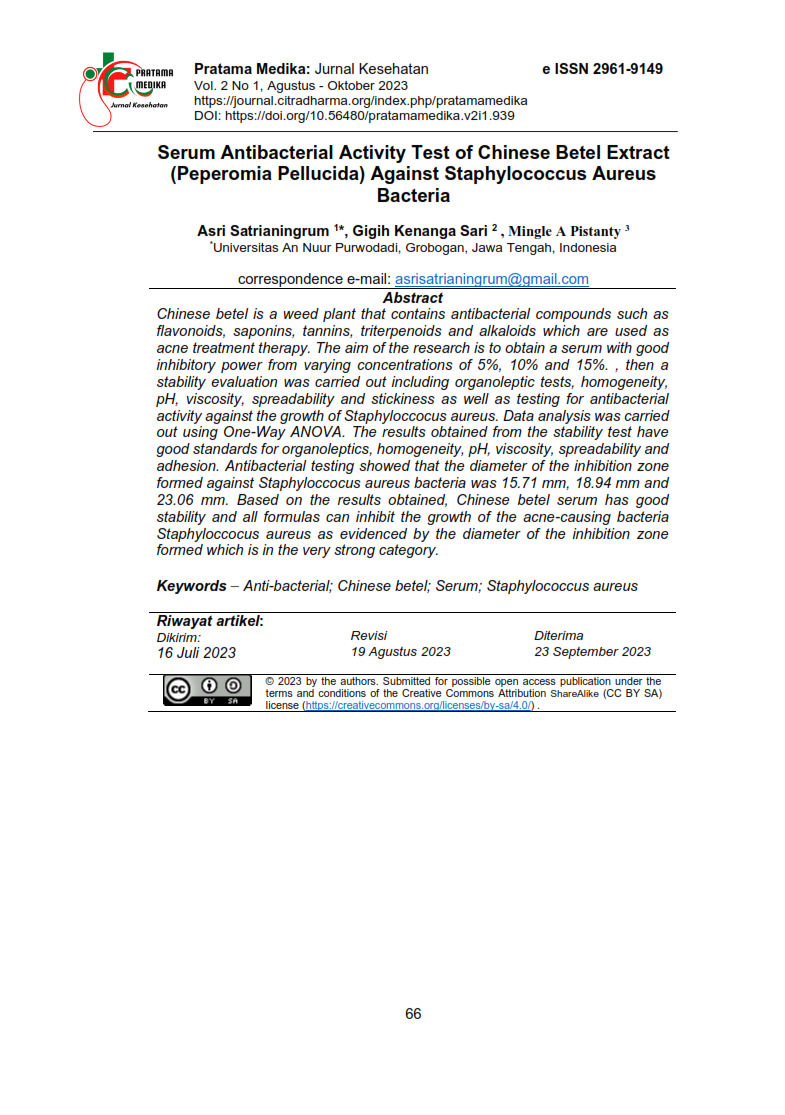Serum Antibacterial Activity Test of Chinese Betel Extract (Peperomia Pellucida) Against Staphylococcus Aureus Bacteria
DOI:
https://doi.org/10.56480/pratamamedika.v2i1.938
 Abstract View:
Abstract View:
372
 PDF downloads:
PDF downloads:
356
Keywords:
Anti-bacterial, Chinese betel, Serum, Staphylococcus aureusAbstract
Chinese betel is a weed plant that contains antibacterial compounds such as flavonoids, saponins, tannins, triterpenoids and alkaloids which are used as acne treatment therapy. The aim of the research is to obtain a serum with good inhibitory power from varying concentrations of 5%, 10% and 15%. , then a stability evaluation was carried out including organoleptic tests, homogeneity, pH, viscosity, spreadability and stickiness as well as testing for antibacterial activity against the growth of Staphyloccocus aureus. Data analysis was carried out using One-Way ANOVA. The results obtained from the stability test have good standards for organoleptics, homogeneity, pH, viscosity, spreadability and adhesion. Antibacterial testing showed that the diameter of the inhibition zone formed against Staphyloccocus aureus bacteria was 15.71 mm, 18.94 mm and 23.06 mm. Based on the results obtained, Chinese betel serum has good stability and all formulas can inhibit the growth of the acne-causing bacteria Staphyloccocus aureus as evidenced by the diameter of the inhibition zone formed which is in the very strong category
References
Adnan J., 2016, Formulasi Gel Ekstrak Daun Beluntas (Pluceaindica Less) dengan Na-CMC sebagai Basis Gel, Journal of Pharmaceutical Science and Herbal Technology, 1(1), pp. 41–44.
Anisah N., 2015, Studi Eksperimen Pembuatan Masker Dengan Komposisi Bunga Pukul Empat, Kencur dan Binahong Untuk Kulit Jerawat, Jurnal Ilmiah, 3(16), p. 40.
Asiyah, Isna Jati. 2019. “Aktivitas Antibakteri Ekstrak Daun Suruhan (Peperomia pellucida L. Kunth). Terhadap Bakteri Staphylococcus aureus.”Jurnal Farmasi Indonesia 16(2):98-105. Doi: 10.311001/Jfi.V16i2.494.
Dewantari. P. R., Suminarti, E. N., dan Tyasmoro, Y. S. 2015. Pengaruh mulsa jerami padi dan frekuensi waktu penyiangan gulma pada pertumbuhan dan hasil Tanaman Kedelai (glycine max (L.) Merril). Jurnal Produksi Tanaman. Vol 3, no 6. 487-495.
Emma S and Pratiwi D., 2014, Evaluasi dan Uji Stabilitas Fisik dan Sineresis Sediaan Gel yang Mengandung Minoksidil, Apigenin dan Perasan Herba Seledri (Apium graveolens L.), Journal Indonesian Bulletin of Health Research, 42(4), p. 20088.
Firmansyah, F., Khairiati, R., Muhtadi, W. K., & Chabib, L. (2020). Uji Aktivitas Antibakteri Serum Ekstrak Etanol Buah Belimbing Wuluh Terhadap Propionibacterium acnes, Staphylococcus aureus, dan Staphylococcus.
Hasrawati A., Hardianti H., Qama A., 2020, Pengembangan Ekstrak Etanol Limbah Biji Pepaya (Carica papaya L.) sebagai Serum Antijerawat, Jurnal Fitofarmaka Indonesia, 7(1), pp. 1–8. doi: 10.33096/jffi.v7i1.458.
Herawati, D., L. Nuraida, dan Sumarto. 2013. Cara Produksi Simplisia Yang Baik. Seafast Center. Institut Pertanian Bogor.
Hutahean. and. Manda. E. 2022, Uji Fitokimia Ekstrak Sirih Cina, Jurnal Farmasi Indonesia.
Illing E., Ilmiati, Safitri, Wulan, 2017, Uji Fitokimia Ekstrak Buah Dengen, Jurnal Dinamika, 8(1), pp. 66–84.
Kementrian Kesehatan Ri. 2017. Farmakope Herbal Indonesia Edisi Ii.
Kurniawati and Wijayanti, 2018, Karakteristik Sediaan Serum Wajah dengan Variasi Konsentrasi Sari Rimpang Temu Giring (Curcuma heyneana) Terfermentasi Lactobacillus bulgaricus, Akademi Farmasi Putra Indonesia, Malang.
Lynn, D. D., Tamara Umari, Caori A. D., Robert P. D., 2016, The Epidemiology of Acne Vulgaris in Late Adolescence, Adolescent Health, Medicine and Therapeutics. 7 : 13-25.
Marina R.R., 2015, Pengaruh Hormon Terhadap Acne Vulgaris (Hormone Influence in Acne Vulgaris), Periodical of Dermatology and Venereology. 27: 118-224.
Naibaho O., Yamlean P., Wiyono W., 2013, Pengaruh Basis Salep terhadap Formulasi Sediaan Salep Ekstrak Daun Kemangi (Ocimum sanctum L.)
Putra, A.Y.T., Supriyadi, and Santoso, U., 2019, Skrining fitokimia ekstrak etil asetat daun simpor (Dillenia suffruticosa). Jurnal Teknologi dan Industri Pangan, 4(1), 36–40.
Putrajaya, F., Hasanah, N., & Kurlya, A. (2019). Daya Hambat Ekstrak Etanol Daun Suruhan (Peperomia Pellucida L.) Terhadap Pertumbuhan Bakteri Penyebab Jerawat (Propionibacterium Acnes) dengan Metode Sumur Agar. Edu Masda Journal, 3(2), 123–140.
Radji, M. 2016. Buku Ajar Mikrobiologi: Panduan Mahasiswa Farmasi Dan Kedokteran. Jakarta: EGC.
Riawenni S., 2017, Aktivitas Antibakteri Krim Antijerawat yang Mengandung Ekstrak Daun Sirih Hijau ( Piper betle L .) terhadap Propionibacterium acnes, Meiching.
Warnida H., Juliannor A., Sukawaty Y., 2016, Formulasi Pasta Gigi Gel Ekstrak Etanol Bawang Dayak (Eleutherine bulbosa (Mill.) Urb.), Jurnal Sains Farmasi & Klinis, 3(1), p. 42. doi:10.29208/jsfk.2016.3.1.98.
Wijaya H., Novitasari. and Jubaidah S., 2018. Perbandingan Metode Ekstraksi Terhadap Rendemen Ekstrak Daun Rambut Laut (Sonneratia caseolaris L. Engl), Jurnal Ilmiah Manuntung, 4(1), pp. 79–83.
Yuri Pratiwi Utami, Burhanuddin Taebe & Fatmawati., 2016. Standarisasi Parameter Spesifik Dan Non Spesifik Ekstrak Etanol Daun Murbei (Morus Alba L.) Asal Kabupaten Soppeng Provinsi Sulawesi Selatan. Sulawesi

Downloads
Published
How to Cite
Issue
Section
License
Copyright (c) 2023 Asri Satrianingrum, Gigih Kenanga Sari, Mingle A Pistanty

This work is licensed under a Creative Commons Attribution-ShareAlike 4.0 International License.
Copyright Notice
Authors who publish with this journal agree to the following terms:
- Authors retain copyright and grant the journal right of first publication with the work simultaneously licensed under a Creative Commons Attribution-ShareAlike 4.0 International License that allows others to share the work with an acknowledgment of the work's authorship and initial publication in this journal.
- Authors are able to enter into separate, additional contractual arrangements for the non-exclusive distribution of the journal's published version of the work (e.g., post it to an institutional repository or publish it in a book), with an acknowledgment of its initial publication in this journal.
- Authors are permitted and encouraged to post their work online (e.g., in institutional repositories or on their website) prior to and during the submission process, as it can lead to productive exchanges, as well as earlier and greater citation of published work (See The Effect of Open Access).

This work is licensed under a Creative Commons Attribution-ShareAlike 4.0 International License.








